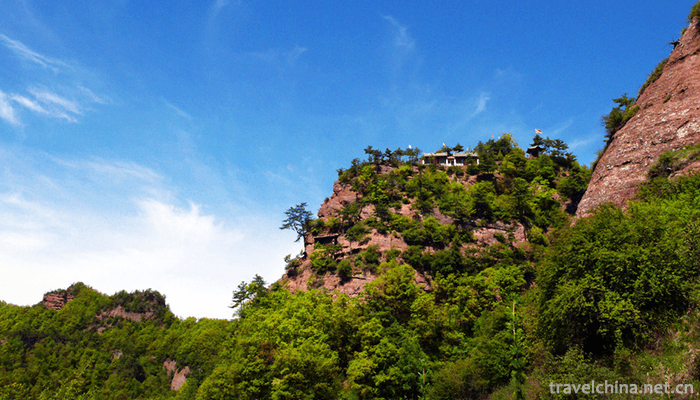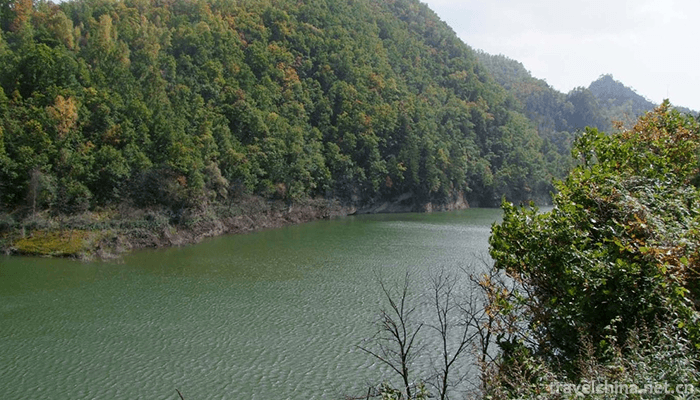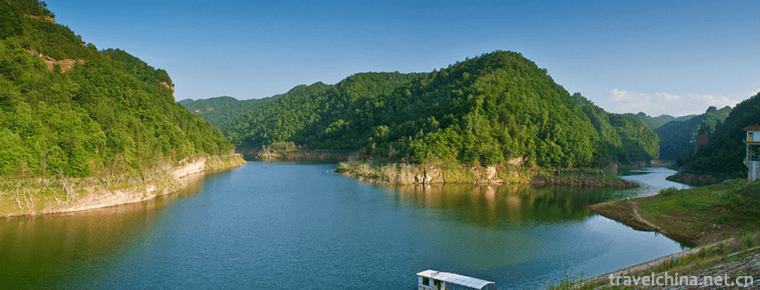Yunya Temple Scenic Area
Yunya Temple Scenic Area is a comprehensive scenic area, which is represented by the unique Danxia landform on the Loess Plateau, and is composed of abundant forest resources, numerous streams and springs, strange peaks, grasslands and meadows, as well as a large number of historical and cultural sites and modern water conservancy projects.
Survey
The park has beautiful mountains, high peaks, dense forests, quiet streams, grotto niches, star cloth, bird dancing and warbler singing, red flowing green everywhere, and strange rocks. The main tree vegetation species are Pinus armandii, Pinus tabulaeformis, Larix gmelinii, Betula platyphylla, Populus davidiana and Cyclobalanopsis glauca. The main animals are leopard, deer, musk deer, roe deer, wild boar, red belly pheasant, ring neck pheasant and other countries, two or three kinds of protected animals* Especially the eight major temples, mainly the Yunya Temple Grottoes, a national cultural relic protection unit, are also located in the park. They are named for the cliff cliffs, the caves of the Northern Wei Dynasty and the post stations of the ancient Silk Road. Bamboo Forest Temple Reservoir is full of green waves, water and sky, which add vitality to the scenic area. The whole scenic area can be summarized as a comprehensive scenic area with colorful plant landscape features, rich Danxia landform features and precious historical and cultural heritage. It can provide tourists with many functions such as leisure and vacation, exploring seclusion, summer and summer resort, popular science research, entertainment, and exploring Buddhist grotto art.
At present, Yunya Temple Scenic Area has been named National Forest Park, National Water Conservancy Scenic Area, National Key Cultural Protection Units and National AAAA Tourist Scenic Area successively.
Scenic area:
The specific location geographic coordinates are between 35 latitudes north. 07'00"- 35. 15'33"and East Meridian 106. 14'54~106. Between 24'00. It is 16.1 km long in North and south, 13.98 km wide in East and west, and has a total area of 223365 mu, of which 40,000 Mu is the core area. The specific scope is as follows: the Jing-Gan Highway is bounded in the north, and the two sides of Jing-Gan Highway extend eastward to both sides of the highway at Shiqiao Forest Farm; the Yunya Temple and Hongya Temple are bounded in the south; the natural gully between Hongya Temple and Dagoumen is bounded in the east; the natural gully between Gaoyaozi Liang, Gaoyaozi Valley, Dujia Dawan is extended to the south of Jinggan Highway; and the Dashizhuang Valley and Xitaigou are bounded in the west. Bound. Part of the land used in the reservoir, Dasi Gully, Dasi Chigou, Hongya Temple, Gaoyaozi Liang, Gaoyaozi Gully and the section of Jinggan Highway from Shiqiao to Zhulin Temple are included.
Introduction of scenic spots:
Yunya Temple is famous for its cliff-like sky and grottoes of the Northern Wei Dynasty. Yunya Temple was founded in the Northern Wei Dynasty. After being expanded in the Northern Zhou, Jin, Yuan, Ming and Qing dynasties, it has formed a spectacular scene of eight temples, three caves, one view, one bay and one pool. It is the post station of the ancient Silk Road.
Zhulinsi Reservoir
The main waterscape scenic spot of the forest park is located on the east side of Zhulin Temple, one of the eight temples. It was built in 1996 with a storage capacity of 6.12 million cubic meters and a total investment of 41.44 million yuan. It is the largest water conservancy project in Pingliang since the founding of the People's Republic of China. In 2002, the Ministry of Water Resources was listed as the national water resources scenic spot.
Cloud cliff Temple
One of the Eight Temples in the main scenic spot of the forest park is located in the south of the entrance of the park gate. It was built in the third year of Taiping Zhenjun in the Northern Wei Dynasty (442 A.D.). The shape of the mountain resembles that of Maiduo, known as "wheat hill". It is named after the dolomite cave in the third layer of the grottoes on rainy days. Now the most complete and exquisite cave is Wufang Buddhist cave.
Bee stock
Located in Luohan Cliff of Xitai of Yunya Temple, it is named after numerous stone nests formed by wind and rain erosion on cliff cliffs, which resemble honeycombs.
Park gate
Located in Zhulin Temple, one of the eight temples, built in 2007, the main scenic spot of Shanmen is composed of tourist center, shopping center, square, parking lot, station and eco-botanical garden. The total area of the building is 12,000 square meters, the greening area is 6,800 square meters, and the investment is 3.6 million yuan.
Block stone
One of the main scenic spots of the forest park is located one kilometer north of Yunya Temple. The mountain is very dangerous and the mountain body is prominent. People enter the forest park. When they look up, they can only see the stone, but not the sky, so they get their name.
The Jade Emperor is extremely strong.
The main peak of Yunya Temple, like a giant bell, is magnificent and precipitous. It is said to be the altar for monks of Yunya Temple to worship heaven.
Trial axe mountain
It is also called Nantai (one of the four platforms of Yunya Temple). In the chronicles, it is called "Turtle Crane Play". Its wall is cut to a height of 100 feet, and there is a crack in the mountain body. It is said that when Chen Xiangzi split the mountain to save his mother, he passed by the place and left traces of axe test, so he got his name.
Carpenter cliff
Located 1.5 kilometers south of Yunya Temple, the Dasi Gully is said to have jumped off the cliff after the completion of the construction of the Yunya Temple caves. Later generations commemorate his great achievements, in this statue to commemorate, so the famous carpenter cliff.
Hongya Temple
Located 5 kilometers southeast of Yunya Temple, one of the "Eight Monasteries" in the forest park is named after the cave was excavated on Chifeng, which is about 200 meters long and 60 meters high. There are 14 caves numbered, and the larger caves are Thousand Buddha Cave and Baizi Cave of Wenwang.
Three fairy cliff
Located in the scenic spot of Hongya Temple, it is said that three Taoist worshippers, Laojun Taishang, Tianzun Yuanshi and Tongtian Church, often came here to recite scriptures and discuss Taoism and got their names.
Mixed stone
Located on the east side of the temple, it is said that when Jade Emperor Zhang Bainen was in charge of the three boundaries, he often opened the South Tianmen Gate for the convenience of summoning the gods. Later, the rebels attacked the South Tianmen Gate. In order to guard the heaven, a monk of the temple moved a huge stone from the top of the chaotic yuan to block the South Tianmen and quell the rebellion. However, he moved the huge stone to the middle of the mountain of the temple and left it because of his inability.
The swing frame
Located one kilometer north of Yunya Temple, also known as "Double Peaks Looking at the Sun". It is said that the Queen Mother was named for her swing here, which is one of the important scenic spots.
Bamboo forest temple
Located at the entrance of the Forest Park 2 kilometers north of Yunya Temple, one of the Eight Temples in the park, the grottoes are distributed on the cliffs about 100 meters long and 80 meters high. There are 5 numbered caves and 6 statues. It is named for the arrow bamboo forest around the temple, but due to historical reasons, the protection of the arrow bamboo forest is inadequate and destroyed.
Guan Shan Lin Hai
Forest Park forest landscape, in the forest sea of about 220,000 mu, distributes more than 1000 species of forest plants in 60 families. It is a natural paradise for national key protected animals such as leopard, Sika deer, red belly pheasant and so on. The natural forest communities with mixed needles and broad-leaved trees constitute different forest seasonal landscape in spring, summer, autumn and winter, which is magnificent.
Chesspan ridge
Located in Beitai of Yunya Temple, it is said that Lu Dongbin and Han Zhong got their name from playing chess here, and Pinus armandii distributed around the mountains sprouted and forested the Momordica grosvenorii brought by the two immortals from the fairyland.
Beacon Hill
Also known as Lion Ridge, located in the east side of Guanyin Mountain in Dongtai of Yunya Temple, the mountain is undulating and looks like a penholder. The literati and Mohists named it Bijiashan because of its mountain shape.
Fairy head
Located on the top of Yingshan Mountain in Xitai of Yunya Temple, the top of the mountain is a huge stone like an eagle, which is proud of the sky and like the head of a giant. Yunya Temple is one of the important scenic spots.
Jin wa Temple
Wafoyegou, located 1 kilometer north of Yunya Temple, is one of the Eight Temples in the scenic area. There are few caves and Buddhist statues preserved and the construction time is unknown.
Roof view
Cloud Cliff Temple in the east, Jinwa Temple in the west, sitting in the north and south, and Yuhuangding into sister peaks, terrain dangerous, cliff steep wall, face to face with immortal head, swing frame bamboo forest lake, National Forest Park Fengling. The concept of Tiantai was founded by Quanzhen school's disciples Liu Fatong of the 29th generation, who led disciples Zhang Xinglong, Li Xingsheng and all the inhabitants. It was built in 1980. After more than 20 years of hard work and foundation, the scale has been initially built. There are dozens of holes excavated: Yuhuang Cave, Baiyun Cave, Yaowang Cave, Sanhuang Cave, Zushi Cave, Xuannu Cave and Residential Cave.
Xiang Zi cave
Located in Guanyin Mountain, Dongtai, Yunya Temple, it is said that a long time ago, when Han Xiangzi visited the Queen Mother, he passed through the cave and found that it was quiet and elegant. He often came here to play the flute. Later generations called it "Xiangzi Cave".
Mt. Mt.
Also known as Stone Stacks, is located in the south of Dasi 1 km of the stone temple beam, because the shape of the mountain is similar to the wheat stack named.
Guanyin Mountain
The East platform of the four platforms of Yunya Temple is very dangerous. It looks up like a lion squatting and looks down at Ruodan Phoenix spreading its wings.
Ju Xian Bridge
Dashizhuang Gougou, 1 kilometer south of Yunya Temple, was built in 2008 as a wooden-like building scenic spot in the forest park.
The Heavenly Southern Gate
Shimenzi, also known as Shimenzi, is situated 2 kilometers east of Dasi Oil Basket Tank. The two mountains confront each other and form a wide gap between them. It resembles the city gate. Tourists and Mohists named it "Nantianmen" because of its mountain shape.
Mahavihara
Located 2 kilometers south of Yunya Temple, one of the "Eight Monasteries" in the forest park, the grottoes are distributed on the cliff wall 1 kilometer apart and arranged in a zigzag pattern of "people". There are 12 grotto niches (only 4 relics), 3 stone statues and most of the cultural relics were destroyed during the Cultural Revolution.
Sacrifice cliff
Situated in the Dasi ditch on the north side of the Dasi Temple, its walls are cut, about 90 meters high. In ancient times, there are trestles. Shanghais often go to the Dasi to worship Buddhas through trestles. Because of the high and dangerous cliffs, Shanghais often fall under the cliffs, but devout Buddhist disciples still flock to it.
Three layers of cliff
Shibaozi, located one kilometer south of Yunya Temple, is named for its regular arrangement of three-storey rocky cliffs, which are about 80 meters high.
Development:
Yunya Temple is the leading scenic spot of tourism development in our county, and also the core scenic spot of planning and layout of Pingliang Guanshan tourism economic zone. In recent years, the county Party committee and the county government have raised more than 860 million yuan to speed up the development and construction of Yunya Temple scenic spot in an all-round way, in accordance with the strategic layout of the city's tourism industry and the decision-making plan of strengthening the tourism industry. First, the management of scenic spots has been strengthened. The Yunyasi Tourism Administration Bureau was established, with full-time staff, and the management system was straightened out. Second, infrastructure has been improved. On transportation, 28 kilometers of high-grade highway from County town to scenic area, 15 kilometers of Scenic Area Road and 6 kilometers of scenic area footpath were built, new cruise ship wharf and parking lot were built, cruise ships and passenger transport vehicles were purchased, and special bus lines were opened to scenic area; on tourism, mountain gates, tourist service centers, activity Plaza and a number of pavilions, pavilions, galleries and bridges were built in scenic area. Points, equipped with tourist leisure and activities facilities, set up more eye-catching sightseeing signs; (3) power communication, power supply lines 3 km, communication cable 2.5 km, installation of mobile communication base tower 5; (4) sanitation, purchased garbage trucks, built three three-star tourist toilets, in the scenic area of reasonable allocation of garbage cans and trash cans; (5) shopping services, Scenic shopping centers, local product centers and folk exhibition halls have been built, and catering service centers with Zhuanglang snacks as the main part have been opened. Third, publicity and promotion have been further strengthened. For two consecutive years, Yunyasi Cultural Tourism Festival has been successfully held. Many groups have participated in the Western Trade Fair, the Western Trade Fair, the Lanzhou Trade Fair and the domestic tourism fair, and widely promoted. Since 2007, the number of tourists and tourism income in Yunya Temple scenic spot have increased by more than 20% annually.
During the Twelfth Five-Year Plan period, according to the new requirements of the layout and centralized breakthroughs of the city's tourism industry, the development of Yunya Temple scenic spot will seize the policy opportunities of supporting the development of tourism industry by the state and provinces and municipalities, strive to make breakthroughs in scale expansion, in construction grade and service level, and strive to build Yunya Temple into a city after Kongtong Mountain in three to five years. A 5A class tourist attraction with high popularity both inside and outside the province. Four aspects should be emphasized: first, according to the national standard of 5A scenic spots, we should complete the detailed plan for the development and construction of Yunyasi National Scenic Spot and the feasibility study report on the infrastructure construction of scenic spots; second, we should strive for the national and provincial key scenic spot development projects and the provincial key scenic spot construction financial discount loans to speed up the pace of the construction of scenic spots in an all-round way; Thirdly, we should speed up the training of talents and improve the management and service level of scenic spots. Fourthly, we should carry out extensive publicity and promotion so as to integrate Yunya Temple scenic spots into the Silver and Gold tourist routes of New Zealand as soon as possible.




-
2.Xibaipo Scenic Area Pingshan County Shijiazhuang
Xibaipo is located in the middle of Pingshan County, Shijiazhuang City, Hebei Province, with a total area of 16,440 square meters. It was the seat of the CPC Central Committee
Time 2018-11-24 -
3.Cangyan Mountain Scenic Area
Cangyan Mountain, located 50 kilometers southwest of Shijiazhuang City, Hebei Province, is located in Jinglong County. As the core scenic spot of Cangyan Mountain, Cangyan Mountain Fuqing Temple is li
Time 2019-01-04 -
4.Yangtze River Source of Tuotuo River
Tuotuo River: Located in Tanggula Mountain Town, Southern Region of Golmud City, Qinghai Province, it is the West source of the Yangtze River, south of the Hoh Xili Mountains.
Time 2019-02-22 -
6.Traditional Toys Tancheng Wooden Rotary Toys
Tancheng Wooden Rotary Toy is an ancient traditional handicraft. Originated in Fanyuan Village, north of Gangshang Town, Tancheng County, Linyi City, Shandong Province, it is commonly known as "p
Time 2019-04-21 -
7.Nuwa Festival
Nuwa Festival is an ancient traditional folk custom and folk religious and cultural activity. Legend has it that the eighteenth day of the third month of the lunar calendar is Nuwa's birthday. Therefo
Time 2019-06-08 -
8.Hunan Opera
Hunan Opera, is one of the traditional operas in Hunan Province. It is popular in Changsha and Xiangtan, mainly in the twelve genera of Changsha Mansion, namely Changsha, Shanhua, Xiangyin, Liling, Xi
Time 2019-07-03 -
9.Couplet Custom
Couplet is a couplet inscribed on the pillar of the couplet, also refers to the couplet, is a unique form of literature and art in China. The custom of couplets originated from the dual phenomenon of
Time 2019-07-14 -
10.Huanglongxi ancient town
According to the annals of Renshou County, the ancient name of Huanglong river is Chishui. According to the annals of Renshou County, Chishui River confluences with Jinjiang River. The water is brown and the river is clear.
Time 2020-11-06 -
11.Donghekou earthquake site park
Donghekou earthquake site park, located in Qingchuan County, Guangyuan City, Sichuan Province, is the first earthquake site protection memorial site of Wenchuan earthquake. On November 12, 2008, the opening ceremony and the launching ceremony of the tourism market after the earthquake were held.
Time 2020-11-08 -
12.Soil characteristics of Suining
The strata in Suining City are mainly limestone in the lower part and purplish red sandy soil and mudstone in the upper part. Therefore, Suining area is also known as "red soil land".
Time 2020-12-16